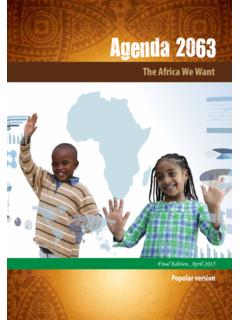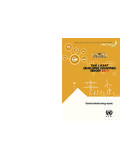Transcription of Global agriculture towards 2050 - Home | Food and ...
1 The challengeAgriculture in the 21st century faces multiple challenges: it has to produce more food and fibre to feed a growing population with a smaller rural labour force, more feedstocks for a potentially huge bioenergy market, contribute to overall development in the many agriculture -dependent developing countries, adopt more efficient and sustainable production methods and adapt to climate change. food demand and productionWorld population is expected to grow by over a third, or billion people, between 2009 and 2050. This is a much slower rate of growth than the one seen in the past four decades during which it grew by billion people, or more than 90 percent. Nearly all of this growth is forecast to take place in the developing countries.
2 Among the latter group, sub-Saharan africa s population would grow the fastest (+114 percent) and East and Southeast Asia s the slowest (+13 percent). Urbanization is foreseen to continue at an accelerating pace with urban areas to account for 70 percent of world population in 2050 (up from 49 percent at present) and rural population, after peaking sometime in the next decade, actually the same time, per capita incomes in 2050 are projected to be a multiple of today s levels. There is a consensus among analysts that recent trends whereby the economies of developing countries have been growing significantly faster that the developed ones is likely to continue in the future. Relative inequality in per capita incomes would be reduced considerably by 2050.
3 However, absolute differences would remain pronounced and could even increase further, given the current huge gaps in absolute per capita incomes. Moreover, inter-country and inter-regional inequalities within the present-day developing world would tend to become more pronounced. The projected Global economic growth of about percent annually would lead to a significant reduction or even near elimination of absolute economic poverty in the developing countries (persons living on less than US$ in 2005 prices). Nevertheless, even in 2050 the world will still be far from solving the problem of economic deprivation and malnutrition of significant parts of the population: the US$ poverty line is simply too low.
4 On less stringent criteria, deprivation and undernutrition will remain widespread, though significantly less than today. These trends mean that market demand for food would continue to grow. Demand for cereals, for both food and animal feed uses is projected to reach some 3 billion tonnes by 2050, up from today s nearly billion tonnes. The advent of biofuels Global agriculture towards 2050population growthSource: UN Population Division, from van der Mensbrugghe et al. 2009 Developedother DevelopingLeast DevelopedWorld10987654321019501955196019 6519701975198019851990199520002005201020 152020202520302035204020452050 BillionHigh Level Expert Forum - How to Feed the World in 2050 Office of the Director, Agricultural Development Economics DivisionEconomic and Social Development DepartmentViale delle Terme di Caracalla, 00153 Rome, Italy Tel: (+39) 06 57053354 Fax: (+39) 06 570 53056172 Email: the potential to change some of the projected trends and cause world demand to be higher, depending mainly on energy prices and government policies.
5 The demand for other food products that are more responsive to higher incomes in the developing countries (such as livestock and dairy products, vegetable oils) will grow much faster than that for cereals. The projections show that feeding a world population of billion people in 2050 would require raising overall food production by some 70 percent between 2005/07 and 2050. Production in the developing countries would need to almost double. This implies significant increases in the production of several key commodities. Annual cereal production, for instance, would have to grow by almost one billion tonnes, meat production by over 200 million tonnes to a total of 470 million tonnes in 2050, 72 percent of which in the developing countries, up from the 58 percent today.
6 Feeding the world population adequately would also mean producing the kinds of foods that are lacking to ensure nutrition tradeTrade in agricultural commodities is also expected to expand considerably. For example, net cereal imports into the developing countries would increase almost three-fold to reach nearly 300 million tonnes by 2050 and, by then, would account for some 14 percent of their cereal consumption, up from percent in 2006/08. Cereals self-sufficiency would continue to be low in the region most dependent on food imports ( in the Near East/North africa ) falling further from 59 percent in 2006/08 to 54 percent in 2050. At the other extreme, Latin America and Caribbean, now a net cereals deficit area, may become fully self-sufficient reflecting the surplus production potential of major countries in the region.
7 The other regions may see some decline in self-sufficiency, but they will remain in the 80 to 95 percent range compared with 83 to 100 percent at present. Concerning other major commodities, developing countries net exports of oilseeds and vegetable oils would more than triple by 2050 to some 25 million tonnes (in oil equivalent) and net exports of sugar double to some 20 million tonnes by 2050. Again, the advent of biofuels has the potential of altering these prospects as all three commodity groups are used for feedstocks in biofuel resourcesNinety percent of the growth in crop production globally (80 percent in developing countries) is expected to come from higher yields and increased cropping intensity, with the remainder coming from land expansion.
8 Arable land would expand by some 70 million ha (or less then 5 percent), with the expansion in developing countries by about 120 million ha (or 12 percent) being offset by a decline of some 50 million ha (or 8 percent) in the developed countries. Almost all of the land expansion in developing countries would take place in sub-Saharan africa and Latin equipped for irrigation would expand by some 32 million ha (11 percent), while harvested irrigated land would expand by 17 percent. All of this increase would be in the developing countries. Due to a slowly improving efficiency in water use and a decline in the area under rice (which is relatively intensive in water use), water withdrawals for irrigation would grow at a slower pace but still increase by almost 11 percent (or some 286 cubic km) by 2050.
9 The pressure on renewable water resources from irrigation would remain severe and could even increase slightly in several countries in the Near East/North africa and South yields would continue to grow but at a slower rate than in the past. This process of decelerating growth has already been under way for some time. On average, annual crop yield growth rate over the projection period would be about half ( percent) of its historical growth rate ( percent; and percent for the developing countries). Cereal yield growth would slowdown to percent per annum ( percent in developing countries), and average cereal yield would by 2050 reach some tonne/ha, up from tonne/ha at tHe projected increases in land, Water use and yields feasible?
10 The Global Agro-Ecological Zone study shows that there are still ample land resources with potential for crop production available, but this result needs to be heavily qualified. Much of the suitable land not yet Source: Simulation results with World Bank s ENVISAGE model, from van der Mensbrugghe et al. 2009160140120100806040200$ trillion at constant 2004 values2005201020152020202520302035204020 452050percent per annum876543210income growth High-income country growth (right-axis)Developing country growth (right-axis)High-income GDp (left-axis)Developing country GDp (left-axis)in use is concentrated in a few countries in Latin America and sub-Saharan africa , but many countries with growing rural populations in these regions are extremely land-scarce, and much of the potential land is suitable for growing only a few crops that are not necessarily those for which there is the highest demand.

















